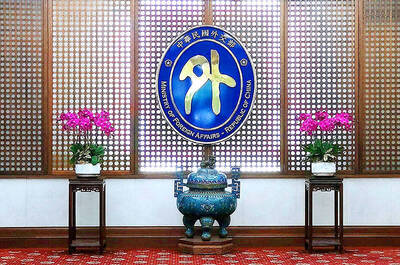A new 10-year long-term care services program would more than double the number of service items covered by the plan from eight to 17, with the number of beneficiaries increasing by more than 200,000 people, the Ministry of Health and Welfare said yesterday.
Announcing the results of a meeting by an interministerial task force on Friday to discuss the plan, Deputy Minister of Health and Welfare Lu Pau-ching (呂寶靜) said that the new program — called “long-term care services program 2.0” — would build on the first program introduced in 2007, but the expansion of services would benefit more people, such as people aged 50 and older who have dementia and people under 50 with disabilities.
The program is expected to benefit 738,000 people, a 44 percent increase from the current program’s 511,000 people.
“The main problems [with the current program] are first, the money available is not enough,” Lu said.
The second and third major problems are insufficient home and community care services, as well as care personnel, and a gap between resources allocated to urban and rural areas, she said.
For the new program, a budget of NT$20.7 billion would be allocated for its implementation next year, she said.
The new long-term care system will comprise three levels, she said, with the first level consisting of “community-based integrated service centers,” including hospitals, multifunctional daycare centers and service stations in remote areas.
The second level will be “combined daycare service centers,” which are mainly local health bureaus, she said.
The third will involve establishing 2,529 “long-term care stations in alleys and lanes,” and within four years, the ministry hopes to have at least one station in every three villages or boroughs and hired care personnel at each station, Lu said.
The stations can be manned by social welfare groups, community development associations, village offices or farmers or fishermen’s associations, and would provide services such as temporary care and delivering meals, she said.
Lu said that the three levels would be like long-term care flagship stores, specialized stores and neighborhood grocery shops.
As for the problem of insufficient personnel, which is mainly due to low wages and little pay differential, Lu said that the ministry would seek to raise the monthly salary for long-term carers to NT$30,000, and to adjust hourly wages according to working time shifts, as well as the condition and location of the care receivers.
In addition, Lu said the new program would deal with transportation problems by providing shuttle buses that would take people in need of care services to and from care facilities.
Asked whether the planned budget of NT$20.7 billion would be enough to cover care services for 738,000 people, Lu said that just as not all people who feel ill make use of the National Health Insurance system, as they seek other solutions that they feel comfortable with, the ministry does not expect all eligible beneficiaries to make use of the services.
She said the ministry’s preliminary estimation is that only about 50 to 55 percent of eligible beneficiaries would make use of the program’s services.

ALIGNED THINKING: Taiwan and Japan have a mutual interest in trade, culture and engineering, and can work together for stability, Cho Jung-tai said Taiwan and Japan are two like-minded countries willing to work together to form a “safety barrier” in the Indo-Pacific region, Premier Cho Jung-tai (卓榮泰) yesterday said at the opening ceremony of the 35th Taiwan-Japan Modern Engineering and Technology Symposium in Taipei. Taiwan and Japan are close geographically and closer emotionally, he added. Citing the overflowing of a barrier lake in the Mataian River (馬太鞍溪) in September, Cho said the submersible water level sensors given by Japan during the disaster helped Taiwan monitor the lake’s water levels more accurately. Japan also provided a lot of vaccines early in the outbreak of the COVID-19 pandemic,

Kaohsiung Mayor Chen Chi-mai (陳其邁) on Monday announced light shows and themed traffic lights to welcome fans of South Korean pop group Twice to the port city. The group is to play Kaohsiung on Saturday as part of its “This Is For” world tour. It would be the group’s first performance in Taiwan since its debut 10 years ago. The all-female group consists of five South Koreans, three Japanese and Tainan’s Chou Tzu-yu (周子瑜), the first Taiwan-born and raised member of a South Korean girl group. To promote the group’s arrival, the city has been holding a series of events, including a pop-up

The Ministry of Foreign Affairs (MOFA) yesterday voiced dissatisfaction with the Comprehensive and Progressive Agreement for Trans- Pacific Partnership (CPTPP), whose latest meeting, concluded earlier the same day, appeared not to address the country’s application. In a statement, MOFA said the CPTPP commission had "once again failed to fairly process Taiwan’s application," attributing the inaction to the bloc’s "succumbing to political pressure," without elaborating. Taiwan submitted its CPTPP application under the name "Separate Customs Territory of Taiwan, Penghu, Kinmen and Matsu" on Sept. 22, 2021 -- less than a week after China

TEMPORAL/SPIRITUAL: Beijing’s claim that the next Buddhist leader must come from China is a heavy-handed political maneuver that will fall flat-faced, experts said China’s requirement that the Dalai Lama’s reincarnation to be born in China and approved by Beijing has drawn criticism, with experts at a forum in Taipei yesterday saying that if Beijing were to put forth its own Dalai Lama, the person would not be recognized by the Tibetan Buddhist community. The experts made a remarks at the two-day forum hosted by the Tibet Religious Foundation of His Holiness the Dalai Lama titled: “The Snow Land Forum: Finding Common Ground on Tibet.” China says it has the right to determine the Dalai Lama’s reincarnation, as it claims sovereignty over Tibet since ancient times,